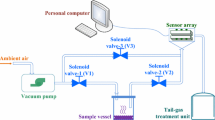Abstract
Growth of the methanogenic archaea, Methanobacterium formicicum, in pure culture was monitored by analysing samples from the gas phase with an array of chemical gas sensors (an `electronic nose'). Analyses of the methane and protein formation rates were used as independent parameters of growth, and the data obtained from the electronic nose were evaluated using principal component analysis (PCA). We found that different growth phases can be distinguished with the electronic nose followed by PCA evaluation. The fast response of the sensors in combination with the high correlations with other parameters measuring growth show that the electronic nose can be a useful tool to rapidly determine methanogenic growth.
Similar content being viewed by others
References
Armgarth A,Söderberg D,Lundström I (1982) Palladium and platinum gate metal-oxide-semiconductor capacitors in hydrogen and oxygen mixtures. Appl. Phys. Lett. 47: 654-655.
Bachinger T,Mandenius C-F (2000a) Physiology motivated monitoring of fermentation processes by means of an electronic nose. Chem. Eng. Technol. (in press).
Bachinger T,Mandenius C-F (2000b) Searching for process information in the aroma of cell cultures. Trends Biotechnol. (in press).
Bachinger T,Mårtensson P,Mandenius C-F (1998) Estimation of biomass and specific growth rate in a recombinant Escherichia coli batch cultivation process using a chemical multisensor array. J. Biotechnol. 60: 55-66.
Bachinger T,Riese U,Eriksson R,Mandenius C-F (2000) Monitoring cellular state transitions in a production-scale CHO-cell process using an electronic nose. J. Biotechnol. 76: 61-71.
Balch W,Wolfe RS (1976) New approach to the cultivation of methanogenic bacteria: 2-mercaptoethanesulfonic acid (HSCoM)-dependent growth of Methanobacterium ruminantum in a pressurized atmosphere. Appl. Environ. Microbiol. 32: 781-791.
Börjesson T,Eklöv T,Jonsson A,Sundgren H,Schnürer J (1996) Electronic nose for odor classification of grains. Cereal Chem. 73: 457-461.
Bryant MP,Boone DR (1987) Isolation and characterisation of Methanobacterium formicicum MF. Int. J. Syst. Bacteriol. 37: 171.
Di Natale C,Mantini A,Macagnano A,Antizzi D,Paolesse R,D'Amico A (1999) Electronic nose analysis of urine samples containing blood. Physiol. Meas. 20: 377-384.
Eklöv T,Johansson G,Winquist F,Lundström I (1998) Monitoring sausage fermentation using an electronic nose. J. Sci. Food Agric. 76: 525-532.
Gardner JW,Bartlett PN (1994) A brief history of electronic noses. Sensors Actuators B18-19: 211-220.
Gardner JW,Craven M,Hines EL (1998) The prediction of bacteria type and culture growth phase by an electronic nose with a multilayer perceptron network. Meas. Sci. Technol. 9: 120-127.
Gardner JW,Hines EL,Wilkinson M (1990) Application of artifi-cial neural networks to an electronic olfactory system. Meas. Sci. Technol. 1: 446-451.
Geladi P,Kowalski BR (1986) Partial least-squares regression: a tutorial. Anal. Chim. Acta 185: 1-17.
Gibson TD,Prosser O,Hulbert JN,Marshall RW,Corcoran P,Lowery P,Ruck-Keene EA,Heron S (1997) Detection and simultaneous identification of microorganisms from headspace samples using an electronic nose. Sensors Actuators B44: 413-422.
Gijzen HJ,Zwart KB,Verhagen FJM,Vogels GD (1988) High-rate two-phase process for the anaerobic degradation of cellulose, employing rumen microorganisms for an efficent acidogenesis. Biotechnol. Bioeng. 31: 418-425.
Godon J-J,Zumstein E,Dabert P,Habouzit F,Moletta R (1997) Molecular microbial diversity of an anaerobic digestor as determinated by small-subunit rDNA sequence analysis. Appl. Environ. Microbiol. 63: 2802-2813.
Gujer W,Zehnder AJB (1983) Conversion processes in anaerobic digestion. Wat. Sci. Technol. 15: 127-167.
Holmberg M,Gustafsson F,Hörnsten EG,Winquist F,Nilsson LE,Ljung L,Lundström I (1998) Bacteria classification based on feature extraction from sensor data. Biotechnol. Tech. 12: 319-324.
Hörnsten EG,Lundström I,Nordberg Å,Mathisen B (1991) The use of palladium metal oxide semiconductor structures in quantitative studies of H2 and H2S in processes related to biogas production. Bioproc. Eng. 6: 235-240.
Hungate RE (1950) The anaerobic mesophilic cellolytic bacteria. Bacteriol. Rev. 14: 1-49.
Jolliffe IT (1986) Principal Component Analysis. New York: Springer-Verlag.
Kalman EL,Winquist F,Lundström I (1997) A new pollen detection method based on an electronic nose. Atmos. Environ. 31: 1715-1719.
Lundström I (1996) Approaches and mechanisms to solid state based sensing. Sensors Actuators B35-36: 11-19.
Lundström I,Armgarth M,Petersson L-G (1989) Physics with catalytic metal gate chemical sensors. CRC Crit. Rev. Solid State Mat. Sci. 15: 201-220.
Mandenius C-F (1999) Electronic noses for bioreactor monitoring. Adv. Biochem. Eng. 66: 65-82.
Mandenius C-F,Hagman A,Dunås F,Sundgren H,Lundström H (1998) A multisensor array for visualizing continous state transitions in biopharmaceutical processes using principal component analysis. Biosens. Bioelectron. 13: 193-199.
Nordberg Å,Hansson M,Sundh I,Nordkvist E,Carlsson H,Mathisen B (2000) Monitoring of a biogas process using electronic gas sensors and near-infrared spectroscopy (NIR). Wat. Sci. Technol. 41: 1-8.
Örlygsson J,Houwen FP,Svensson BH (1993) Anaerobic degradation of protein and the role of methane formation in steady state thermophilic enrichment cultures. Swedish J. Agric. Res. 23: 45-54.
Peterson GL (1983) Determination of total protein. Meth. Enzymol. 91: 95-119.
Raskin L,Zheng D,Griffin ME,Stroot PG,Misra P (1995) Characterization of microbial communities in anaerobic bioreactors using molecular probes. Antonie Leeuwenhoek 68: 297-308.
Stuetz RM,Fenner RA,Engin G (1999) Characterisation of wastewater using an electronic nose. Water Res. 33: 442-452.
Whitman WB,Bowen TL,Boone DR (1992) The methanogenic bacteria. In: Balows A,Trüper HG,Dworkin M,Harder W,Schleifer K-H, eds. The Prokaryotes. A Handbook on the Biology of Bacteria: Ecophysiology, Isolation, Identification, Applications, 2nd edn., Vol. 1. New York: Springer-Verlag, pp. 719-767.
Zehnder AJB,Huser BA,Brock TD,Wuhrmann K (1980) Characterization of an acetate-decarboxylating non-hydrogen-oxidizing methane bacterium. Arch. Microbiol. 124: 1-11.
Zellner G,Macario AJL,de Macario EC (1996) Microbial subpopulation in the biofilm attached to the substratum and in the free flocs of a fixed-bed anaerobic bioreactor. Appl. Microbiol. Biotechnol. 46: 443-449.
Author information
Authors and Affiliations
Rights and permissions
About this article
Cite this article
Brandgård, J., Sundh, I., Nordberg, Å. et al. Monitoring growth of the methanogenic archaea Methanobacterium formicicum using an electronic nose. Biotechnology Letters 23, 241–248 (2001). https://doi.org/10.1023/A:1005643606640
Issue Date:
DOI: https://doi.org/10.1023/A:1005643606640




